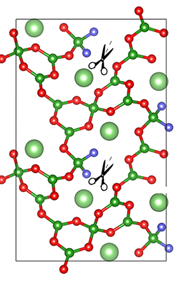Scientists have developed a new class of deep-ultraviolet nonlinear optical (DUV NLO) crystals that promise to be less toxic and have better performance than the materials currently used (Angew. Chem. Int. Ed. 2017, DOI: 10.1002/ anie.201700540). DUV NLO materials are increasingly being used in the semiconductor industry and are crucial in producing solid-state lasers with wide frequency ranges. The fluoro oxoborate KBe2BO3F2, which is the only practical laser material for generating light below 200 nm, has had researchers scrambling for alternatives to avoid further use of toxic beryllium. It also grows in layers, which can reduce its optical properties. Now, a team led by Shilie Pan, vice director of the Chinese Academy of Science’s Xinjiang Technical Institute of Physics & Chemistry, has prepared a class of beryllium-free fluorooxoborate crystals that don’t layer. The team’s strategy involved inserting (BO3F)4−, (BO2F2)3−, or (BOF3)2− groups into three-dimensional boron-oxygen networks. The material works as needed without beryllium, and the synthesis method avoids the formation of terminal oxygen atoms—the existence of which leads to layer formation. One compound in particular, Li2B6O9F2, promises to further “break down the DUV wall for NLO materials,” the researchers report. (C&EN) 
Li2B6O9F2 offers deep-ultraviolet nonlinear optical properties without beryllium and debilitating layering.(Image by XTIPC) Contact: Prof.PAN Shilie E-mail:slpan@ms.xjb.ac.cn Xinjiang Technical Institute of Physics & Chemistry,CAS |
